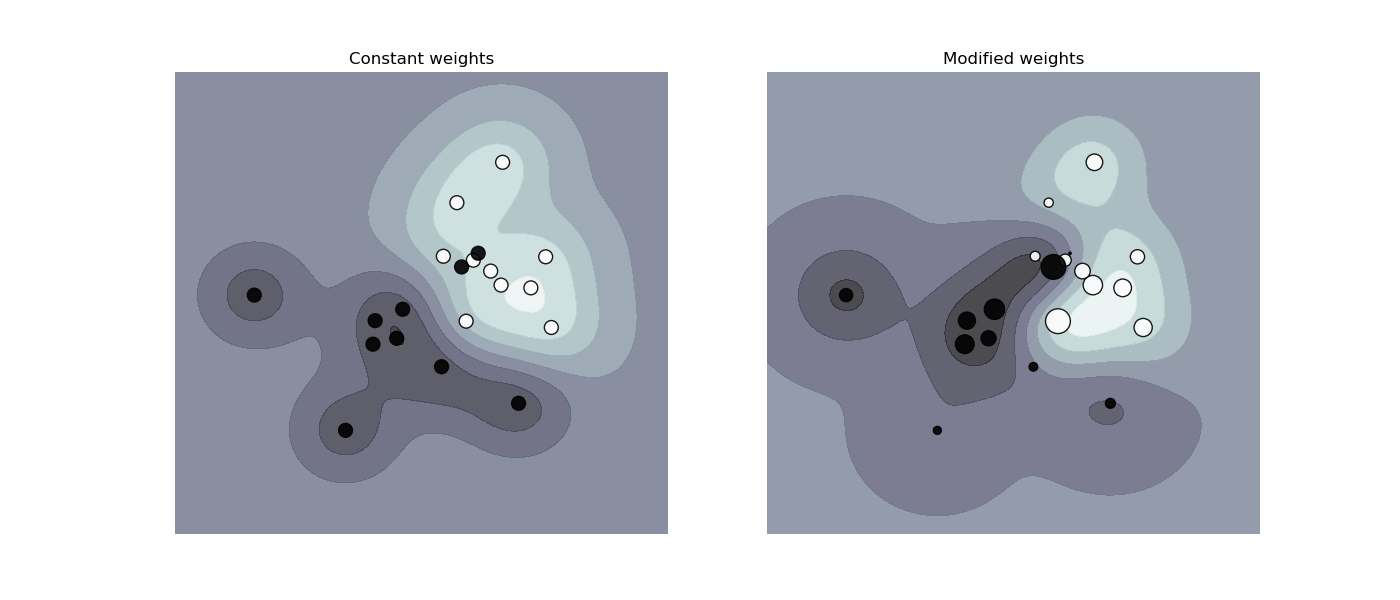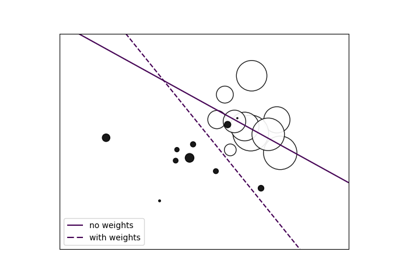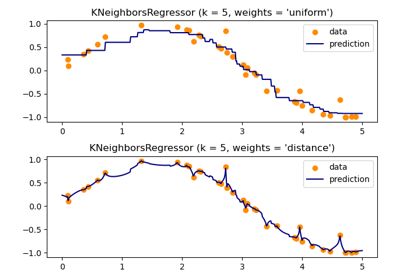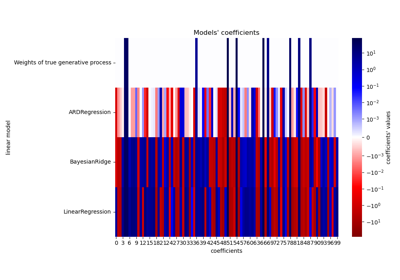注意
转到末尾以下载完整示例代码或通过 JupyterLite 或 Binder 在浏览器中运行此示例。
SVM: 加权样本#
绘制加权数据集的决策函数,其中点的大小与其权重成比例。
样本加权会重新调整 C 参数,这意味着分类器会更加强调正确处理这些点。效果通常可能很微妙。为了在此处强调这种效果,我们特别增加了正类的权重,使得决策边界的变形更加明显。

# Authors: The scikit-learn developers
# SPDX-License-Identifier: BSD-3-Clause
import matplotlib.pyplot as plt
import numpy as np
from sklearn.datasets import make_classification
from sklearn.inspection import DecisionBoundaryDisplay
from sklearn.svm import SVC
X, y = make_classification(
n_samples=1_000,
n_features=2,
n_informative=2,
n_redundant=0,
n_clusters_per_class=1,
class_sep=1.1,
weights=[0.9, 0.1],
random_state=0,
)
# down-sample for plotting
rng = np.random.RandomState(0)
plot_indices = rng.choice(np.arange(X.shape[0]), size=100, replace=True)
X_plot, y_plot = X[plot_indices], y[plot_indices]
def plot_decision_function(classifier, sample_weight, axis, title):
"""Plot the synthetic data and the classifier decision function. Points with
larger sample_weight are mapped to larger circles in the scatter plot."""
axis.scatter(
X_plot[:, 0],
X_plot[:, 1],
c=y_plot,
s=100 * sample_weight[plot_indices],
alpha=0.9,
cmap=plt.cm.bone,
edgecolors="black",
)
DecisionBoundaryDisplay.from_estimator(
classifier,
X_plot,
response_method="decision_function",
alpha=0.75,
ax=axis,
cmap=plt.cm.bone,
)
axis.axis("off")
axis.set_title(title)
# we define constant weights as expected by the plotting function
sample_weight_constant = np.ones(len(X))
# assign random weights to all points
sample_weight_modified = abs(rng.randn(len(X)))
# assign bigger weights to the positive class
positive_class_indices = np.asarray(y == 1).nonzero()[0]
sample_weight_modified[positive_class_indices] *= 15
# This model does not include sample weights.
clf_no_weights = SVC(gamma=1)
clf_no_weights.fit(X, y)
# This other model includes sample weights.
clf_weights = SVC(gamma=1)
clf_weights.fit(X, y, sample_weight=sample_weight_modified)
fig, axes = plt.subplots(1, 2, figsize=(14, 6))
plot_decision_function(
clf_no_weights, sample_weight_constant, axes[0], "Constant weights"
)
plot_decision_function(clf_weights, sample_weight_modified, axes[1], "Modified weights")
plt.show()
脚本总运行时间: (0 minutes 0.251 seconds)
相关示例



